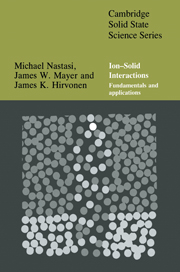Book contents
- Frontmatter
- Contents
- List of symbols
- Preface
- Chapter 1 General features and fundamental concepts
- Chapter 2 Interatomic potentials
- Chapter 3 Dynamics of binary elastic collisions
- Chapter 4 Cross-section
- Chapter 5 Ion stopping
- Chapter 6 Ion range and range distribution
- Chapter 7 Radiation damage and spikes
- Chapter 8 Ion–solid simulations and diffusion
- Chapter 9 Sputtering
- Chapter 10 Order–disorder and ion implantation metallurgy
- Chapter 11 Ion beam mixing
- Chapter 12 Phase transformations
- Chapter 13 Ion beam assisted deposition
- Chapter 14 Applications of ion beam processing techniques
- Chapter 15 Ion beam system features
- Appendix A Crystallography
- Appendix B Table of the elements
- Appendix C Density of states
- Appendix D Derivation of the Thomas–Fermi differential equation
- Appendix E Center-of-mass and laboratory scattering angles
- Appendix F Miedema's semi-empirical model for the enthalpy of formation in the liquid and solid states
- Appendix G Implantation metallurgy – study of equilibrium alloys
- Appendix H Physical constants, conversions and useful combinations
- Index
Chapter 7 - Radiation damage and spikes
Published online by Cambridge University Press: 27 January 2010
- Frontmatter
- Contents
- List of symbols
- Preface
- Chapter 1 General features and fundamental concepts
- Chapter 2 Interatomic potentials
- Chapter 3 Dynamics of binary elastic collisions
- Chapter 4 Cross-section
- Chapter 5 Ion stopping
- Chapter 6 Ion range and range distribution
- Chapter 7 Radiation damage and spikes
- Chapter 8 Ion–solid simulations and diffusion
- Chapter 9 Sputtering
- Chapter 10 Order–disorder and ion implantation metallurgy
- Chapter 11 Ion beam mixing
- Chapter 12 Phase transformations
- Chapter 13 Ion beam assisted deposition
- Chapter 14 Applications of ion beam processing techniques
- Chapter 15 Ion beam system features
- Appendix A Crystallography
- Appendix B Table of the elements
- Appendix C Density of states
- Appendix D Derivation of the Thomas–Fermi differential equation
- Appendix E Center-of-mass and laboratory scattering angles
- Appendix F Miedema's semi-empirical model for the enthalpy of formation in the liquid and solid states
- Appendix G Implantation metallurgy – study of equilibrium alloys
- Appendix H Physical constants, conversions and useful combinations
- Index
Summary
Introduction
It has been known for many years that bombardment of a crystal with energetic (kilo-electron-volts to mega-electron-volts) heavy ions produces regions of lattice disorder. The disorder can be directly observed by techniques sensitive to lattice structure, such as electron-transmission microscopy, MeV-particle channeling, and electron diffraction. The use of these and other techniques, along with the theoretical treatment of ion interactions in solids, has provided a basis for evaluation of implantation processes.
As an ion slows down and comes to rest in a crystal, it makes a number of collisions with the lattice atoms. In these collisions, sufficient energy may be transferred from the ion to displace an atom from its lattice site. Lattice atoms which are displaced by incident ions are called primary knock-on atoms or PKAs. The PKAs can in turn displace other atoms, secondary knock-on atoms, tertiary knock-ons, etc. – thus creating a cascade of atomic collisions. This leads to a distribution of vacancies, interstitial atoms, and other types of lattice disorder in the region around the ion track. As the number of ions incident on the crystal increases, the individual disordered regions begin to overlap. At some point, a heavily damaged layer is formed. The total amount of disorder and the distribution in depth depend on ion species, temperature, energy, total dose, and channeling effects.
Radiation damage and displacement energy
Radiation damage theories are based on the assumption that a lattice atom struck by an energetic ion or recoiling target atom must receive a minimum amount of energy in the collision to be displaced from its lattice site.
- Type
- Chapter
- Information
- Ion-Solid InteractionsFundamentals and Applications, pp. 141 - 190Publisher: Cambridge University PressPrint publication year: 1996
- 1
- Cited by



